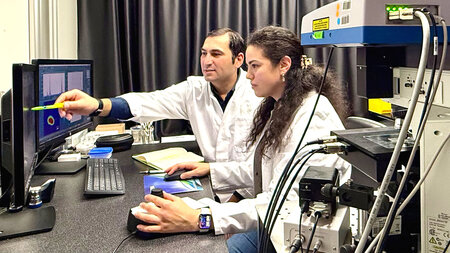Guidance System Designed for Targeted Catalyst Development
Research team from Chemnitz University of Technology and the Max Planck Institute for Chemical Physics of Solids in Dresden develops new concept for catalyst research
-

Prof. Dr. Marc Armbrüster is the head of the Professorship of Materials for Innovative Energy Concepts at Chemnitz University of Technology. Photo: Jacob Müller
Everywhere, substances are transformed by chemical reactions - for example in the human body for energy supply, in cars for exhaust gas purification, or in the chemical industry for fertilizers, as well as fine and basic chemicals. Catalysts are very often used to make these reactions as efficient as possible, i.e. with low energy consumption, and as selective as possible, i.e. without side reactions. In short, catalysts can lower production costs and reduce pollutants. A research team led by Prof. Dr. Marc Armbrüster, head of the Professorship of Materials for Innovative Energy Concepts at Chemnitz University of Technology, and the Max Planck Institute for Chemical Physics of Solids in Dresden under Prof. Juri Grin has now succeeded in investigating the intrinsic contributions to catalytic activity separately. This allows effective catalysts to be developed in a targeted manner and thus more quickly. The researchers published the results of their study in the renowned Journal of the American Chemical Society (JACS).
The path to outstanding catalytic properties
The intrinsic properties can be divided into so-called "geometric" and "electronic" effects. Geometric effects can be thought of as the arrangement and spacing between individual atoms on the catalyst surface where the reaction takes place. Electronic effects can be described, for example, by the number of electrons per unit volume in the catalyst material. Both effects depend on the material, i.e. the elements used and the structure that is formed. Since one inevitably influences both proportions by changing the catalyst composition, an independent investigation, let alone their respective optimization, has not been possible until now. "By using intermetallic compounds, we succeeded in fixing the geometric arrangement on the catalyst surface, while the targeted exchange of individual elements either changes the distance between the atoms or varies the number of electrons in the material" says Armbrüster. The team thus developed a guidance system that rapidly leads to superior materials through targeted exchange. This was tested using the electrochemical oxidation of methanol, a potential storage molecule for the energy transition. Here, through the appropriate combination of electronic and geometric effects, outstanding catalytic properties could be achieved, which could enable an effective energetic use of methanol.
Guidance system enables effective development of catalyst materials
Catalyst research usually proceeds empirically, i.e. by trial and error and reliance on empirical values. "The perfect catalyst for a specific process is like the proverbial needle in a haystack, and the scientist relies on his or her experience in the search," says Armbrüster. In the past 20 years, however, it has often been possible to relate the intrinsic properties of catalyst materials to their selectivity and activity. The new control system will enable effective development of catalyst materials that can then be used in numerous reactions - for example, for the use of renewable energy sources as part of the energy transition.
Publication: Disentangling Electronic and Geometric Effects in Electrocatalysis through Substitution in Isostructural Intermetallic Compound. Ridha Zerdoumi, Oksana Matselko, Leonard Rößner, Bidushi Sarkar, Yuri Grin, and Marc Armbrüster. Journal of the American Chemical Society 144, 2022, 8379-8388. DOI: 10.1021/jacs.2c03348
For further information, please contact Prof. Dr. Marc Armbrüster, phone +49 371 531-36176, e-mail marc.armbruester@chemie.tu-chemnitz.de.
(Translation: Brent Benofsky)
Mario Steinebach
30.05.2022




